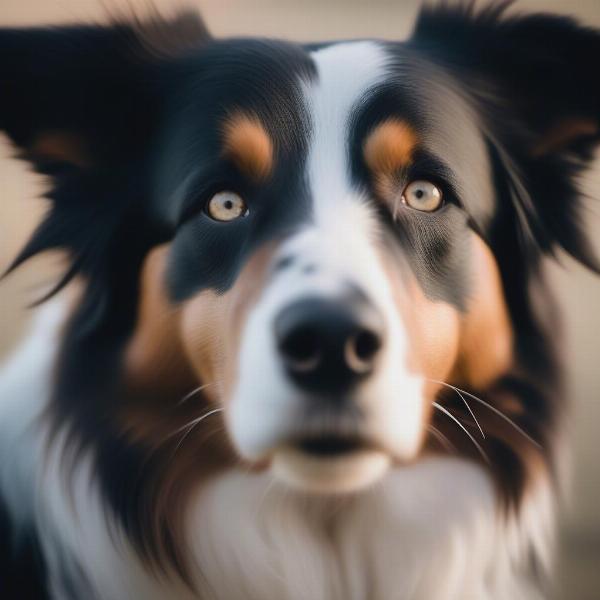Sheepdogs and wolves, despite their vastly different roles in human society, share a common ancestor. This close relationship often leads to questions about their similarities and differences. This article explores the fascinating connection between sheepdogs and wolves, delving into their genetics, behavior, and the crucial role they play in our world. Understanding these remarkable animals provides valuable insights into canine evolution and the complex relationship between humans and animals.
Genetic Links and Evolutionary Paths
Both sheepdogs and wolves belong to the Canis lupus species. While wolves represent the wild, untamed branch of this species, domestic dogs, including sheepdogs, are a subspecies – Canis lupus familiaris. Thousands of years of selective breeding have shaped dogs into the diverse array of breeds we see today, each with specific traits honed for particular tasks. Sheepdogs, for instance, were bred for their herding instincts, intelligence, and ability to work cooperatively with humans.
Wolves, on the other hand, evolved in the wild, facing natural selection pressures that favored survival skills like hunting, pack cooperation, and territorial defense. This different evolutionary journey has led to distinct physical and behavioral differences between wolves and sheepdogs.
Behavioral Contrasts: Herding vs. Hunting
Perhaps the most striking difference between sheepdogs and wolves lies in their behavior. Sheepdogs, especially breeds like Border Collies and Australian Shepherds, display an innate herding instinct, using subtle movements and stares to control the movement of livestock.  Border Collie's intense stare This behavior is a modified form of predatory behavior seen in wolves, channeled into managing flocks instead of hunting prey.
Border Collie's intense stare This behavior is a modified form of predatory behavior seen in wolves, channeled into managing flocks instead of hunting prey.
Wolves, as apex predators, exhibit highly developed hunting strategies, relying on pack coordination and cunning to bring down prey. Their social structure, with a strict hierarchy within the pack, plays a vital role in their hunting success. While sheepdogs can also be social animals, their interaction with humans and other dogs is generally less hierarchical and more cooperative.
Physical Distinctions: Size, Build, and Coat
Physically, while there can be overlap in size depending on the breed, wolves are typically larger and more powerfully built than sheepdogs. They have longer legs, larger paws, and stronger jaws adapted for hunting. Their coat is typically thicker and denser, providing insulation against harsh weather conditions. Sheepdogs, depending on the breed, can have a variety of coat types, from short and smooth to long and shaggy. sable color dog
The Role of Socialization and Training
Both sheepdogs and wolves are highly intelligent animals capable of learning and adapting. However, their social needs and responses to training differ significantly. Sheepdogs thrive on human interaction and respond well to positive reinforcement training methods. Early socialization is crucial for them to develop into well-adjusted companions. sable color in dogs
Wolves, while capable of forming strong bonds with humans, particularly if raised from a young age, retain their wild instincts and require specialized handling. Their pack mentality and territorial nature make them unsuitable as pets for most people.
Can a Sheepdog Be Mistaken for a Wolf?
While some sheepdog breeds, particularly those with thicker coats and more pointed features, might resemble wolves at a glance, closer examination reveals distinct differences. Expert analysis of physical features, behavior, and genetic markers can easily distinguish between the two. sheep costumes for dogs
Conclusion
The shared ancestry of sheepdogs and wolves is a testament to the remarkable adaptability of the Canis lupus species. While millennia of selective breeding have molded sheepdogs into invaluable partners for humans, wolves continue to play a critical role in maintaining the balance of natural ecosystems. Understanding their similarities and differences provides a deeper appreciation for the intricate web of life and the profound impact humans have had on shaping the animal kingdom. wolf costume for a dog
FAQ
-
Do sheepdogs have wolf DNA? Yes, all domestic dogs, including sheepdogs, share a common ancestor with wolves and thus have wolf DNA.
-
Can a sheepdog be trained to hunt like a wolf? While sheepdogs retain some predatory instincts, they are not equipped physically or behaviorally to hunt large prey like wolves.
-
Are sheepdogs more intelligent than wolves? Intelligence manifests differently in different species. Wolves excel in survival skills, while sheepdogs excel in tasks related to herding and human cooperation.
-
Can a wolf be a good pet? Wolves are wild animals with complex social needs and are not suitable as pets for most people.
-
What are some common sheepdog breeds? Common sheepdog breeds include Border Collies, Australian Shepherds, Old English Sheepdogs, and Shetland Sheepdogs.
ILM Dog is a leading international website dedicated to providing expert advice on all aspects of dog care and breeding. We offer valuable resources for dog owners and enthusiasts worldwide, covering everything from breed selection and health care to training and nutrition. Whether you’re a seasoned dog owner or just starting your journey, ILM Dog is your trusted source for comprehensive and reliable information. Contact us at [email protected] or +44 20-3965-8624 for personalized guidance on all your dog-related needs.